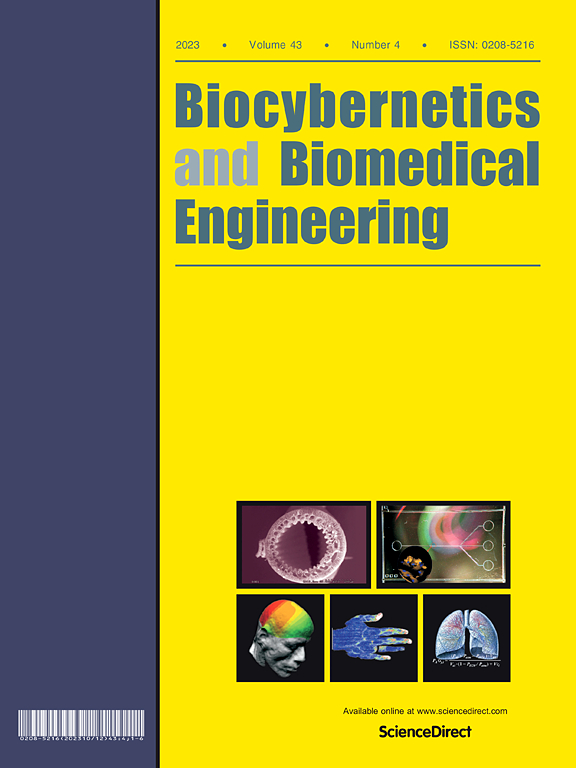一种无线、可植入、双通道膈神经刺激器,用于使用电磁共振耦合的膈神经起搏
IF 6.6
2区 医学
Q1 ENGINEERING, BIOMEDICAL
引用次数: 0
摘要
目的植入式膈肌起搏(DP)系统能有效恢复患者的呼吸。传统的膜片起搏器在实际应用中存在传输不稳定、价格昂贵等局限性。本研究提出了一种创新的、无线供电的双通道和廉价的DP系统来克服这些限制。方法实现基于电磁谐振耦合的无线供电,提高系统的稳定性。它包括一个外部控制器,两个离体发射器和两个体内整流集成接收器。无线系统中的能量传输采用PCB螺旋线圈,保证了系统的稳定性和处理的便捷性。用生物相容性PDMS封装的接收器将接收的功率转换为电刺激能量。通过刺激波形、多媒体环境和动物实验验证了系统的性能。计算人体组织的比吸收率(SAR)以确认植入的安全性。结果所提出的DP系统的电刺激参数可精确调节。刺激幅度范围为3 ~ 12v,步进分辨率为0.1 V。脉冲宽度和频率分别在100-300µs和10-100 Hz范围内可调。呼吸周期和吸入时间也可以单独设置。无线能量传输具有传输距离宽(> 14mm)、抗偏移能力好(水平偏移>8mm)和植入安全性(SAR<1.6 W/kg)等优点。两个通道发出的刺激信号的进一步时间序列是同步的。该系统通过17毫米无线能量传输距离,在体内植入两个接收器,有效地实现了动物对双侧膈神经刺激的呼吸反应。结论本工作为植入式隔膜起搏器的优化设计提供了一种新的方案。本文章由计算机程序翻译,如有差异,请以英文原文为准。
A wireless, implantable, dual-channel phrenic nerve stimulator for diaphragm pacing using electromagnetic resonance coupling
Objectives
Implantable diaphragm pacing (DP) system can effectively restore patients’ breathing.
Conventional diaphragm pacemakers have some practical limitations, such as transmission stability and high price. This study proposes an innovative, wirelessly powered dual-channel and inexpensive DP system to overcome some of these constraints.
Methods
The system realizes wireless power supply based on electromagnetic resonance coupling to improve stability. It comprised an external controller, two off-body transmitters and two in-vivo rectifier-integrated receivers. PCB spiral coils are used for energy transmission in wireless systems to ensure system stability and convenient processing. Receiver encapsulated with biocompatible PDMS convert received power into electrical stimulation energy. Stimulation waveform, multi-media environment and animal experimental tests were conducted to validate system’s performance. Specific absorption rate (SAR) in human tissue was calculated to confirm safety of implantation.
Results
Electrical stimulation parameters of the proposed DP system can be precisely adjusted. The stimulation amplitude range is 3–12 V with 0.1 V step resolution. Pulse width and frequency are adjustable from 100-300 µs and 10–100 Hz respectively. The breathing cycle and inhalation time can also be set individually. Wireless energy transmission has wide transmission distance (>14 mm), good anti-offset capability (horizontal offset>8mm) and implantation safety (SAR<1.6 W/kg). Further time series of stimulation signals issued by the two channels are synchronized. The developed system effectively realizes respiratory response of animals to bilateral phrenic nerve stimulation with 17 mm wireless energy transmission distance and implantation of two receivers in vivo.
Conclusion
Our work provides a new optimization scheme for the design of implantable diaphragm pacemaker.
求助全文
通过发布文献求助,成功后即可免费获取论文全文。
去求助
来源期刊

Biocybernetics and Biomedical Engineering
ENGINEERING, BIOMEDICAL-
CiteScore
16.50
自引率
6.20%
发文量
77
审稿时长
38 days
期刊介绍:
Biocybernetics and Biomedical Engineering is a quarterly journal, founded in 1981, devoted to publishing the results of original, innovative and creative research investigations in the field of Biocybernetics and biomedical engineering, which bridges mathematical, physical, chemical and engineering methods and technology to analyse physiological processes in living organisms as well as to develop methods, devices and systems used in biology and medicine, mainly in medical diagnosis, monitoring systems and therapy. The Journal''s mission is to advance scientific discovery into new or improved standards of care, and promotion a wide-ranging exchange between science and its application to humans.
 求助内容:
求助内容: 应助结果提醒方式:
应助结果提醒方式:


